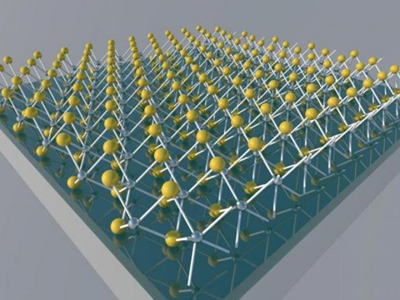
The engineers used a single layer of molybdenum disulfide (MoS 2), a two-dimensional semiconductor that is commonly used in lubricants and steel alloys, on top of a photonic structure called an optical nanocavity made of aluminum oxide and aluminum.

Researchers at the University of Buffalo in New York have used a two dimensional 'nanocavity' material to boost the efficiency of solar panels.
The engineers used a single layer of molybdenum disulfide (MoS 2), a two-dimensional semiconductor that is commonly used in lubricants and steel alloys, on top of a photonic structure called an optical nanocavity made of aluminum oxide and aluminum. This nanocavity is an arrangement of mirrors that allows beams of light to circulate in closed paths, and the addition of the MoS 2 layer increases the amount of light that ultrathin semiconducting materials absorb. In turn, this could help industry to continue manufacturing more powerful, efficient and flexible electronic devices.
The 2D layer boosts absoroption of light to 70% at 450nm, boosting the energy available for conversion and, potentially, the overall efficiency of a solar cell. "The nanocavity we have developed has many potential applications," said Dr Qiaoqiang Gan, assistant professor of electrical engineering in the University at Buffalo's School of Engineering and Applied Sciences. "It could potentially be used to create more efficient and flexible solar panels, and faster photodetectors for video cameras and other devices. It may even be used to produce hydrogen fuel through water splitting more efficiently."
A single layer of MoS 2 is an advantage as, unlike graphene, its bandgap structure is similar to semiconductors used in LEDs, lasers and solar cells.
"In experiments, the nanocavity was able to absorb nearly 70 percent of the 450nm laser we projected on it. Its ability to absorb light and convert that light into available energy could ultimately help industry continue to more energy-efficient electronic devices," said Haomin Song, a PhD candidate and a co-lead researcher on the paper. The nanocavity also modifies the spontaneous emission rate, providing an additional design freedom to control the interaction between light and 2D materials.
A problem for energy-harvesting optoelectronic devices such as solar panels is that these ultrathin semiconductors do not absorb light as well as conventional bulk semiconductors. Therefore, there is an intrinsic tradeoff between the ultrathin semiconductors' optical absorption capacity and their thickness. The nanocavity is a potential solution to this issue.